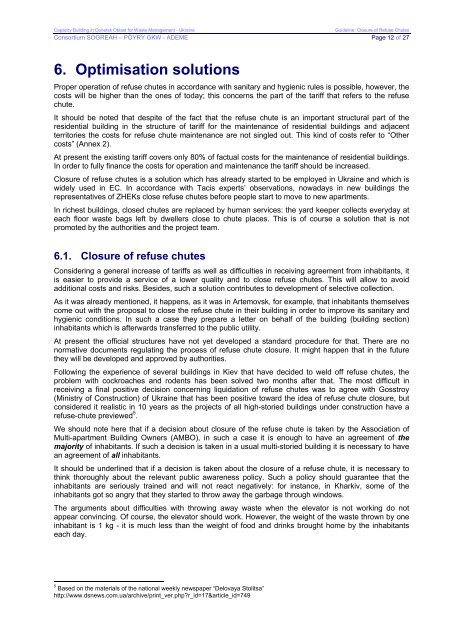UKRAINE Guideline Closure of Refuse Chutes - Ekopro.biz
UKRAINE Guideline Closure of Refuse Chutes - Ekopro.biz
UKRAINE Guideline Closure of Refuse Chutes - Ekopro.biz
Create successful ePaper yourself
Turn your PDF publications into a flip-book with our unique Google optimized e-Paper software.
Capacity Building in Donetsk Oblast for Waste Management - Ukraine <strong>Guideline</strong>: <strong>Closure</strong> <strong>of</strong> <strong>Refuse</strong> <strong>Chutes</strong><br />
Consortium SOGREAH – PÖYRY GKW - ADEME Page 12 <strong>of</strong> 27<br />
6. Optimisation solutions<br />
Proper operation <strong>of</strong> refuse chutes in accordance with sanitary and hygienic rules is possible, however, the<br />
costs will be higher than the ones <strong>of</strong> today; this concerns the part <strong>of</strong> the tariff that refers to the refuse<br />
chute.<br />
It should be noted that despite <strong>of</strong> the fact that the refuse chute is an important structural part <strong>of</strong> the<br />
residential building in the structure <strong>of</strong> tariff for the maintenance <strong>of</strong> residential buildings and adjacent<br />
territories the costs for refuse chute maintenance are not singled out. This kind <strong>of</strong> costs refer to “Other<br />
costs” (Annex 2).<br />
At present the existing tariff covers only 80% <strong>of</strong> factual costs for the maintenance <strong>of</strong> residential buildings.<br />
In order to fully finance the costs for operation and maintenance the tariff should be increased.<br />
<strong>Closure</strong> <strong>of</strong> refuse chutes is a solution which has already started to be employed in Ukraine and which is<br />
widely used in EC. In accordance with Tacis experts’ observations, nowadays in new buildings the<br />
representatives <strong>of</strong> ZHEKs close refuse chutes before people start to move to new apartments.<br />
In richest buildings, closed chutes are replaced by human services: the yard keeper collects everyday at<br />
each floor waste bags left by dwellers close to chute places. This is <strong>of</strong> course a solution that is not<br />
promoted by the authorities and the project team.<br />
6.1. <strong>Closure</strong> <strong>of</strong> refuse chutes<br />
Considering a general increase <strong>of</strong> tariffs as well as difficulties in receiving agreement from inhabitants, it<br />
is easier to provide a service <strong>of</strong> a lower quality and to close refuse chutes. This will allow to avoid<br />
additional costs and risks. Besides, such a solution contributes to development <strong>of</strong> selective collection.<br />
As it was already mentioned, it happens, as it was in Artemovsk, for example, that inhabitants themselves<br />
come out with the proposal to close the refuse chute in their building in order to improve its sanitary and<br />
hygienic conditions. In such a case they prepare a letter on behalf <strong>of</strong> the building (building section)<br />
inhabitants which is afterwards transferred to the public utility.<br />
At present the <strong>of</strong>ficial structures have not yet developed a standard procedure for that. There are no<br />
normative documents regulating the process <strong>of</strong> refuse chute closure. It might happen that in the future<br />
they will be developed and approved by authorities.<br />
Following the experience <strong>of</strong> several buildings in Kiev that have decided to weld <strong>of</strong>f refuse chutes, the<br />
problem with cockroaches and rodents has been solved two months after that. The most difficult in<br />
receiving a final positive decision concerning liquidation <strong>of</strong> refuse chutes was to agree with Gosstroy<br />
(Ministry <strong>of</strong> Construction) <strong>of</strong> Ukraine that has been positive toward the idea <strong>of</strong> refuse chute closure, but<br />
considered it realistic in 10 years as the projects <strong>of</strong> all high-storied buildings under construction have a<br />
refuse-chute previewed 5 .<br />
We should note here that if a decision about closure <strong>of</strong> the refuse chute is taken by the Association <strong>of</strong><br />
Multi-apartment Building Owners (AMBO), in such a case it is enough to have an agreement <strong>of</strong> the<br />
majority <strong>of</strong> inhabitants. If such a decision is taken in a usual multi-storied building it is necessary to have<br />
an agreement <strong>of</strong> all inhabitants.<br />
It should be underlined that if a decision is taken about the closure <strong>of</strong> a refuse chute, it is necessary to<br />
think thoroughly about the relevant public awareness policy. Such a policy should guarantee that the<br />
inhabitants are seriously trained and will not react negatively: for instance, in Kharkiv, some <strong>of</strong> the<br />
inhabitants got so angry that they started to throw away the garbage through windows.<br />
The arguments about difficulties with throwing away waste when the elevator is not working do not<br />
appear convincing. Of course, the elevator should work. However, the weight <strong>of</strong> the waste thrown by one<br />
inhabitant is 1 kg - it is much less than the weight <strong>of</strong> food and drinks brought home by the inhabitants<br />
each day.<br />
5 Based on the materials <strong>of</strong> the national weekly newspaper “Delovaya Stolitsa”<br />
http://www.dsnews.com.ua/archive/print_ver.php?r_id=17&article_id=749


